Landing must be one of the more difficult skills very young raptors need to learn because they spend considerable time practicing it.
This is one of the three youngsters successfully fledged at what I’ve been calling the “cliff nest” to distinguish them from the birds raised in the other two nests I monitored for much of the summer. It’s even possible that this is the same bird as in my recent post of a fledgling doing the “pipe dance” but it could have been any of the three siblings. In these photos, taken on 6/30/17, the bird was six days younger than the one doing the pipe dance. In fact this was the first day I saw the siblings any distance away from the nest so they had only very recently learned to fly at all.
This time I’m going to refer to the bird as a male though I don’t know its sex.
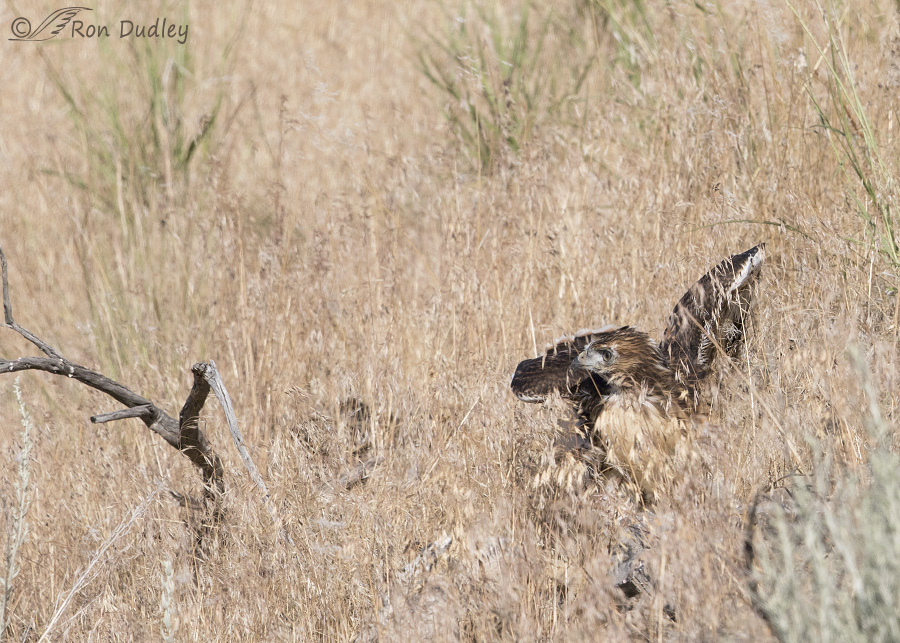
1/4000, f/6.3, ISO 500, Canon 7D Mark II, Canon EF 500mm f/4L IS II USM + EF 1.4 III Extender, not baited, set up or called in
This youngster had previously been perched on the branch we see at left but he jumped down into the grass and then very soon decided to go back to it. I strongly suspect he was deliberately practicing his landing skills and as we’re about to see they definitely needed some fine-tuning.

1/4000, f/6.3, ISO 500, Canon 7D Mark II, Canon EF 500mm f/4L IS II USM + EF 1.4 III Extender, not baited, set up or called in
All that deep grass had to complicate matters because first he had to jump up to clear it as best he could…
1/4000, f/6.3, ISO 500, Canon 7D Mark II, Canon EF 500mm f/4L IS II USM + EF 1.4 III Extender, not baited, set up or called in
before raising his legs and flying forward toward the perch.
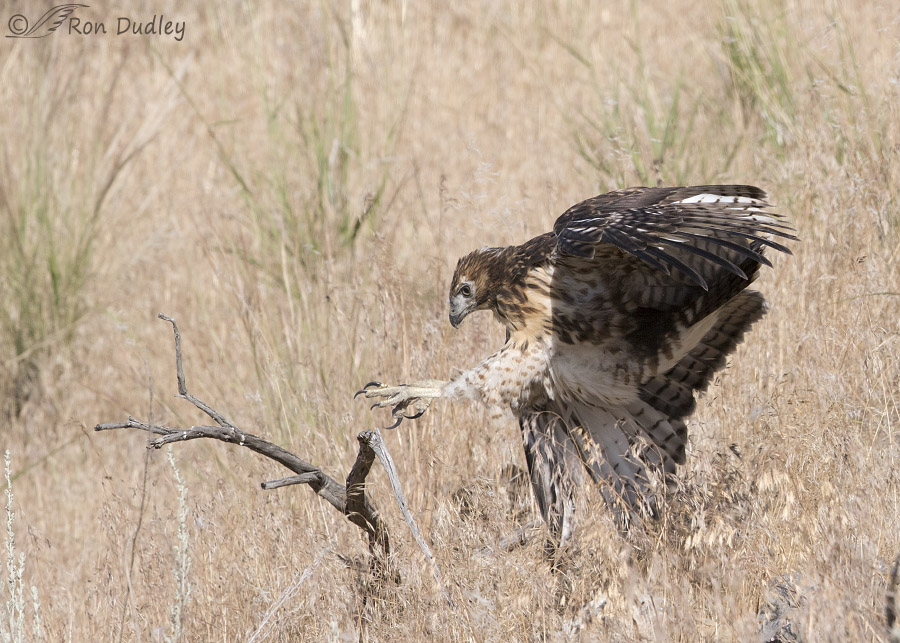
1/3200, f/6.3, ISO 500, Canon 7D Mark II, Canon EF 500mm f/4L IS II USM + EF 1.4 III Extender, not baited, set up or called in
How’s that for concentration and a “big reach”?
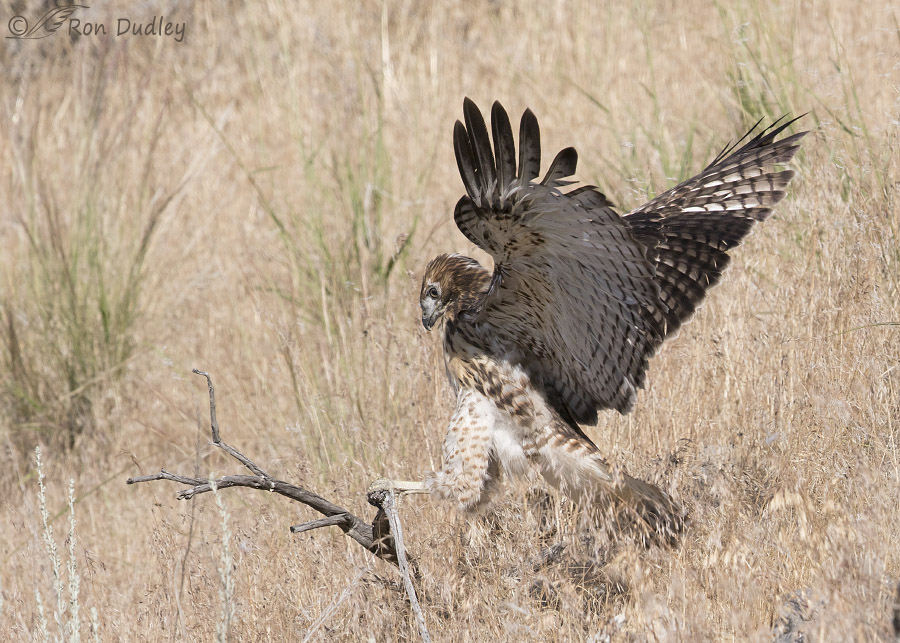
1/4000, f/6.3, ISO 500, Canon 7D Mark II, Canon EF 500mm f/4L IS II USM + EF 1.4 III Extender, not baited, set up or called in
Touchdown – first major goal accomplished. Now all he had to do was…
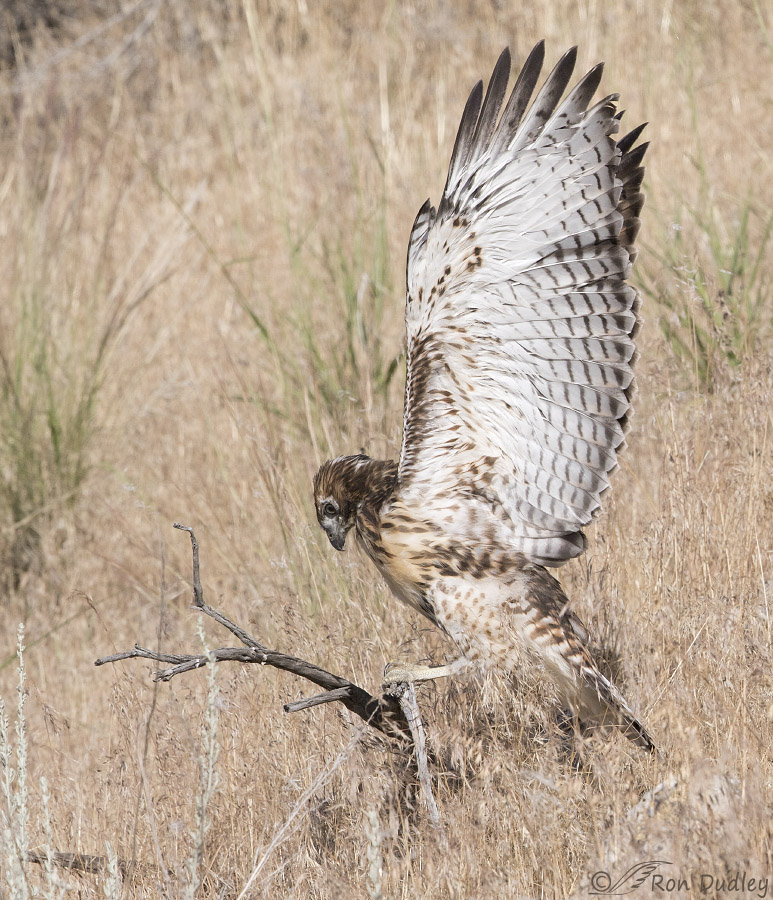
1/4000, f/6.3, ISO 500, Canon 7D Mark II, Canon EF 500mm f/4L IS II USM + EF 1.4 III Extender, not baited, set up or called in
get his center of gravity over the perch and then fold his wings and savor the accomplishment (I love this look at all those beautiful fresh feathers).
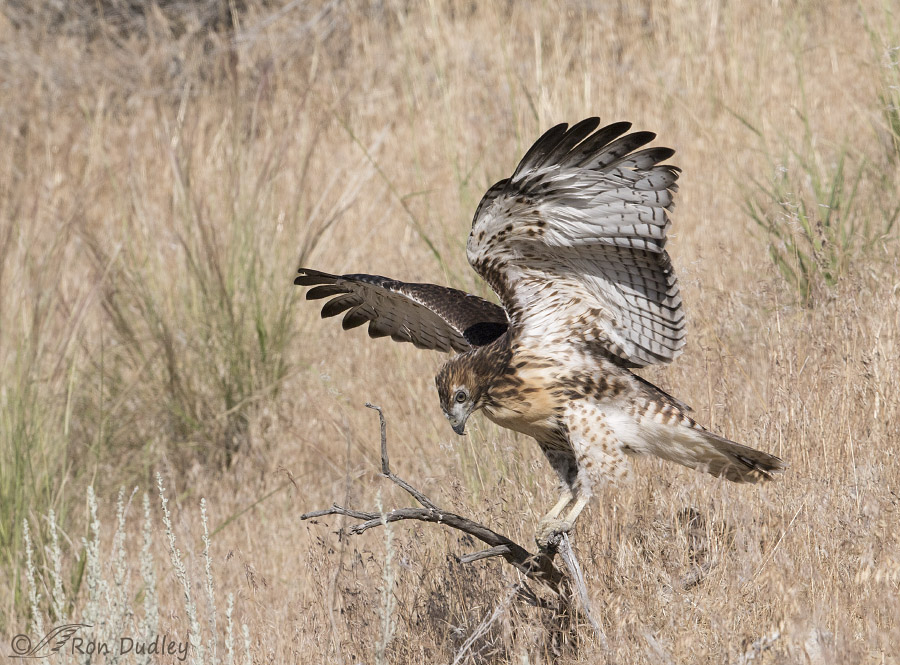
1/4000, f/6.3, ISO 500, Canon 7D Mark II, Canon EF 500mm f/4L IS II USM + EF 1.4 III Extender, not baited, set up or called in
At first I thought he’d nailed the landing…
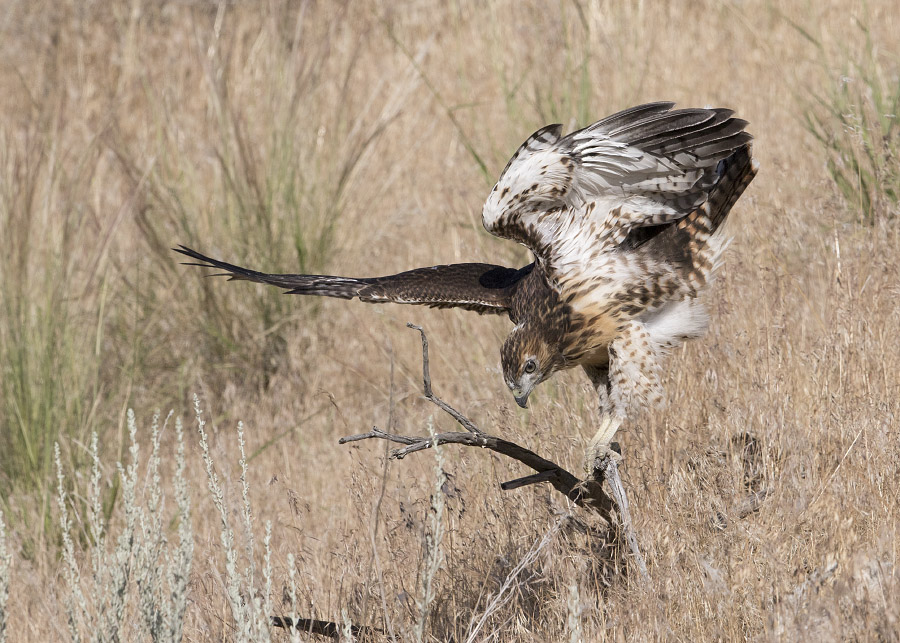
1/4000, f/6.3, ISO 500, Canon 7D Mark II, Canon EF 500mm f/4L IS II USM + EF 1.4 III Extender, not baited, set up or called in
but I was wrong. Almost immediately he tipped forward…
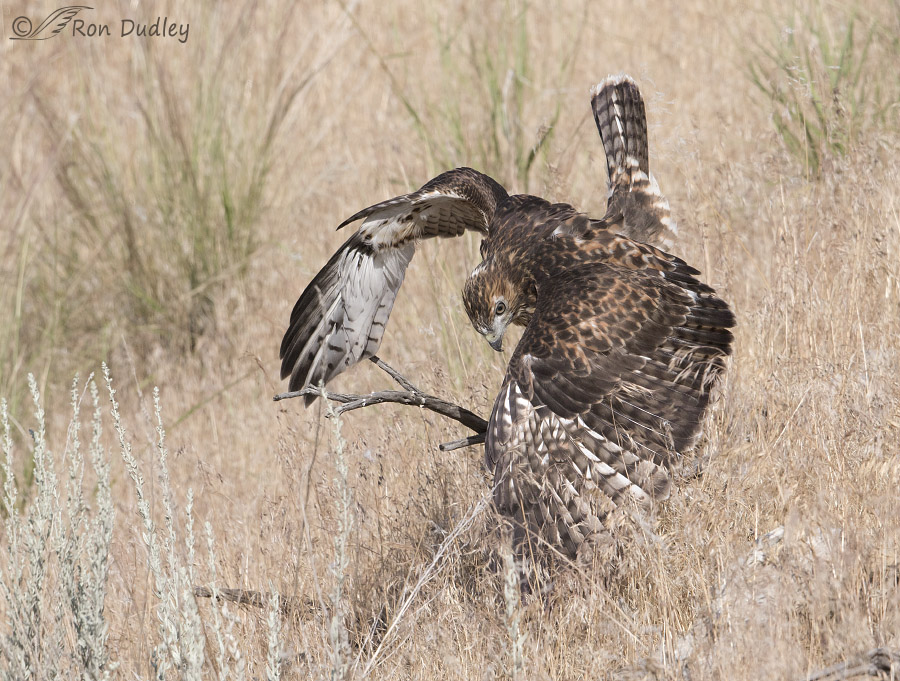
1/2000, f/6.3, ISO 500, Canon 7D Mark II, Canon EF 500mm f/4L IS II USM + EF 1.4 III Extender, not baited, set up or called in
and to his left. He had to struggle for some time before he…
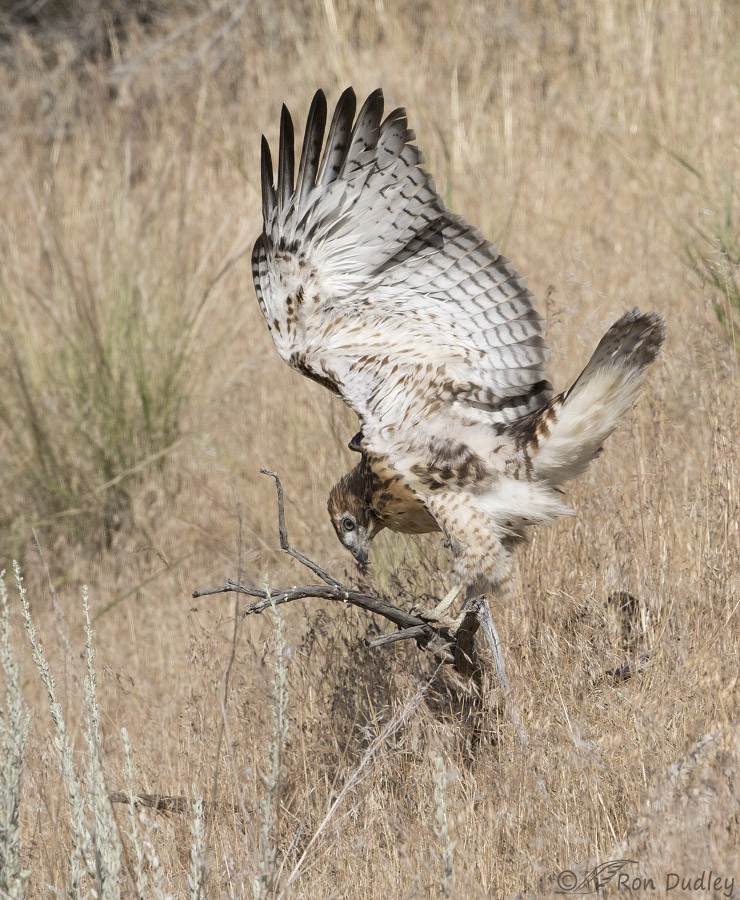
1/5000, f/6.3, ISO 500, Canon 7D Mark II, Canon EF 500mm f/4L IS II USM + EF 1.4 III Extender, not baited, set up or called in
began to stabilize so he could eventually fold his wings and relax. When he did so he faced away from me so I didn’t keep any of those images.
I’ve been photographing raptors for years but until this summer with these young hawks and others I didn’t fully appreciate how much time and effort they devote to honing their skills as very young birds. But taking off, flying, landing and hunting are extremely complex and athletic activities that by definition would require immense amounts of practice to become proficient.
I should have known…
Ron


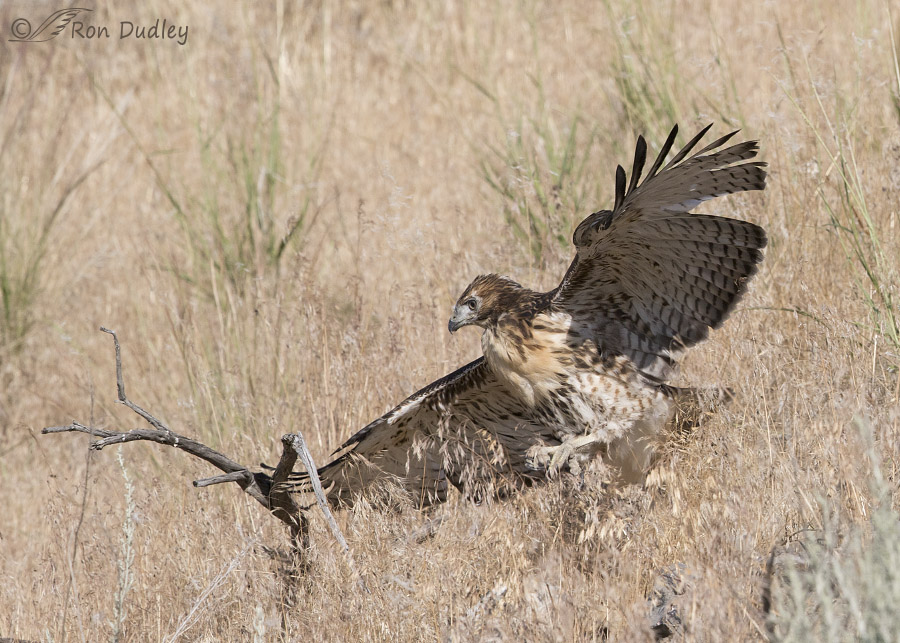
Beautiful!
As long as he doesn’t take a step, it still counts as sticking the landing — no matter how much flailing happens.
It was 90 and humid today. Ick.
Ha, interesting interpretation of the “rules”, Marty.
Hey, the rules are made up and the points don’t matter!
That is one of the prettiest Red Tail Hawk I have ever seen. Love all of your pictures. It gave me a chuckle. Thanks Ron!
I agree, Jean. He’s a stunner.
Echoing everyone else’s applause.
And applauding the VERY fast learner you captured for us.
Awe and wonder. And delight. Which is an impresive start to my day.
Thank you, EC.
A wonderful series, Ron. And the contortions the young one has to go through to catch balance — who knew wings & tail could go every which way, all at once?! Even though I’ve transported a number of raptor fledglings over the years to the Ojai Raptor Center with broken wings, etc., I really hadn’t thought about all the practice they must need to develop their crucial flight and landing skills. Here’s hoping this young Red-tail and its siblings are very good students!
They seemed to be learning fast, Chris. I have high hopes for them.
Very interesting series with great images. That branch he was attempting to land on appeared to be part of his challenge.
He landed on that branch several times and each time he struggled with the landing. He seemed intent on learning how to do it better.
A wonderful, funny series! …love the concentration and intensity of focus…my favoriye is the near nose dive toward the end…
Thanks very much, Patty.
I once had the delight of watching a young red-tail on what had to be her first soar. There was a parent soaring nearby, the youngster was screaming and circling, but then clearly started to freak out when she began to bring in the wings slightly, which (unexpectedly, I think) made her start to go FASTER. I figure it felt out of control as she shifted and headed for a really tall fir, where she slammed ungracefully into a branch. Flying is a big deal but landing is a separate lesson!
That must have been very fun to watch, Louise.
When I tried to teach my crow, Corby, to fly, as he perched on my hand, I moved it up and down, forcing him to flutter his wings…finally, he let go of my hand and flew! In a straight line. Right unto the trunk of a small tree! It took many more attempts before he had any control–of altitude or direction. I was very relieved at each step toward progress…wishing he had a crow role model. He eventually got the hang of it.
This is a marvelous series. Who knew what it took? I guess we should understand that they don’t just automatically do those skilled activities. We have to learn to roll over, crawl and then walk, so it makes sense that a bird would have to learn skills. I’m glad this youngster was smart enough to stay away from the prickly pear in the first couple of shots… And I love all the detail of the feather patterns and the positions it “landed” in.
Lots of dangers out there, Susan. I was always glad to see that all three of these youngsters always seemed to avoid the road.
How fun to watch, thank you for sharing the fun.
I’m glad you enjoyed it, April. Thanks.
Ron, Laura nailed it when she mentions learning how to walk! We don’t try as babies until 9 months earliest, and this beautiful bird is performing athletic maneuvers in a few days that would take us a lifetime of practice!
Maybe having a BIG brain is a handicap when we’re young, LOL.
That big brain would certainly make us top-heavy when we’re learning to walk, Alan! I can think of a politician or two that probably learned to walk at an extremely young age…
Thanks for great behavior images!
It is interesting to see pictures of them practicing in, I’m sure he felt, some privacy! VBG!
I had a great time watching an immature Cooper’s practicing his hunting technique last year. I say watching, because I was only able to catch his moods on the ground. I am sure he didn’t think it was as comical as I did since he wasn’t successful.
Dick, when young birds are this age and concentrating on what they’re doing I don’t think they’re particularly cognizant of many of their surroundings – including me.
What a wonderful series. I LOVE it–who’da guessed that? LOL! The feather detail, the intensity of focus and just the overall beauty knocks my socks off–all the way to the laundry basket!
If you harken back to when you were learning to walk, you had to practice those skills a lot before you mostly mastered the whole thing–and even then, humans have issues with gravity working against us. And you only had to learn roughly half (give or take) of the skills these guys have to figure out to stay alive! I’ve been so blessed to have watched the Cornell redtails from hatch through the post fledging time over five years. It’s a dangerous time for them, and in the first couple of days post fledge, they’re likely to get themselves in trouble as they maneuver through the myriad of obstacles in this world.
Judy the skills are mostly hard wired, but there’s the issue of coordinating all the various little elements (how all the various parts work) involved and working out the fine points to make it all happen.
Again, thank you for beginning my morning with sheer, raw beauty! You ROCK!
I always enjoy your knowledgeable input when it comes to raptors, Laura. Thank you.
Thx Laura, that makes sense………..:)
Sensational series Ron!
Charlotte
Thanks, Charlotte.
As always, I learn something every day from your blog…….I realize now that I had just assumed ( we know what that “does” ) that birds’ flight skills were all instinctive…..thanks for the lesson !
Making assumptions has put me in trouble more than once, Kris – a lesson I’m STILL learning…
Ron, thanks for this excellent educational series with split-second photo intervals and corresponding commentary. Well done, as usual!
I’m glad you enjoyed it, Den. Thank you.
Great series, Ron. He appears to have a “worried” look on his face as he starts and through this task. It was/is surprising to me how much the GHO’s that nest here and these actually have to “learn” on the way to becoming independent. Tend to think these skills are hard wired and, other than they KNOW they need to do it, they aren’t. 40 this morning – welcome after all the heat but also 8 degrees from freezing!
It was/is surprising to me how much the GHO’s that nest here and these actually have to “learn” on the way to becoming independent. Tend to think these skills are hard wired and, other than they KNOW they need to do it, they aren’t. 40 this morning – welcome after all the heat but also 8 degrees from freezing!
Judy, as we both know they have a lot to learn and many that are less proficient don’t make it. I’ve seen stats saying that as many as 70% of them don’t survive their first year. This is serious business for them.
It’s 62° here just before 6 AM. We’ve been cooling off too.